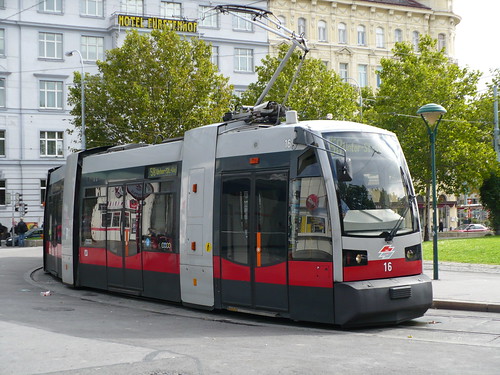
see more pwn and owned pictures
How many of you have seen this type of bad building in your cities around transit? This example above isn't directly transit related, but it shows how sometimes we just aren't doing it right. I took a class in college where my professor discussed universal design, whereby we create places that are accessible for people with disabilities, without having to make special accommodations. It's as easy as making the front door level with the ground without putting in a step.
In the transit world, this means low floor buses/trains and lower ramps. The Portland streetcar and its ramp is a perfect example, it doesn't take a huge lift to get wheelchairs into the vehicle, and it doesn't take 10 minutes to load someone up either. As far as I know, low floor light rail vehicles are now the norm rather than the exception. Some places are even ultra low floor such as this Siemens ULF in Vienna I got to ride.


4 comments:
I've experienced several low-floor light-rail vehicles -- and several low-floor buses. And judging from a rather cursory search, both low-floor LRV's and low-floor buses have become common in recent years.
My favorite example of transit "Fail!" is the construction of the BART/Muni tunnel in downtown San Francisco in the early 1970's. BART service started in 1974, but Muni Metro service only in 1980.
This was because SF Muni had old PCC LRV's, which have an operator cab at only one end, and which thus cannot reverse direction without going in a loop. However, the Muni tunnel is stub-end, meaning that the PCC's cannot turn around in it.
But in 1980, Muni got its Boeing-Vertol LRV's, which follow typical recent LRV designs, including operator cabs at both ends. All that was necessary was to change ends, and these LRV's could thus be used in that tunnel.
The Muni Metro in general is pretty full of fail. Once they did buy their LRVs, they got ones where only two of the four doors on each side could be opened at high platforms, where the ridership was highest. And the original configuration of Embarcadero was always a big constraint on operations, though they did get things running more or less smoothly. And then they go and switch to a new type of LRV, new signal system, and open an extension all at the same time, with predictably disastrous results. Their new LRVs were too power-hungry so they couldn't run three car trains and couldn't couple trains before sending them into the Metro so as to reduce the number of individual trains in the subway. The ATCS system has had reliability problems, and even now, it's rather annoying that trains have to stop to switch to or from ATCS.
All that is operational fail. But if you want to see transit planning fail, consider the VTA system, which serves neither the most transit-dependent corridor (and thus highest demand), nor even the home-to-work commutes for most of silicon valley.
I lived in Berkeley and was working at CIL when AC Transit put in the first lift-equipped buses. Within a couple years, we were witnessing massive problems because a) there was no driver training after the intro of the lifts (which led to a driver telling me that "only wheelchair people could use the lift". At the time i was using a cane and he refused to let me use the lift to go to work.) and b) there weren't qualified maintenance people to fix broken lifts and they broke regularly. There was a (maybe apocryphal) story of a disabled guy who regularly sued ACT in small claims court for this and won every time, paying his way through law school.
i remember the law firm i temped at in SF, which remodeled a historic building (it withstood the big quake and fire) and had great grab bars in great accessible bathrooms, but which had 2 steps up into the building.
Reminds me of the great Fred Small song "Talking Wheelchair Blues" where the woman says to the restaurant owner "you know, there are some things you could do to make this place easier for disabled people to get into" and he says "no, that's okay, handicapped people never come here." (rim shot please)
That's still an amazing photo. You gotta wonder What Were They Thinking?, or um, were they?
The Wheels bus system of Livermore-Pleasanton-Dublin seemed to have mostly-functional lifts; I don't recall many cases of breakdowns. But operating those lifts was rather time-consuming; they'd have to be extended for each use and retracted afterwards.
That agency eventually got low-floor buses, which are easier for wheelchair-bound passengers -- they have ramps which can be pulled out for such passengers.
Post a Comment